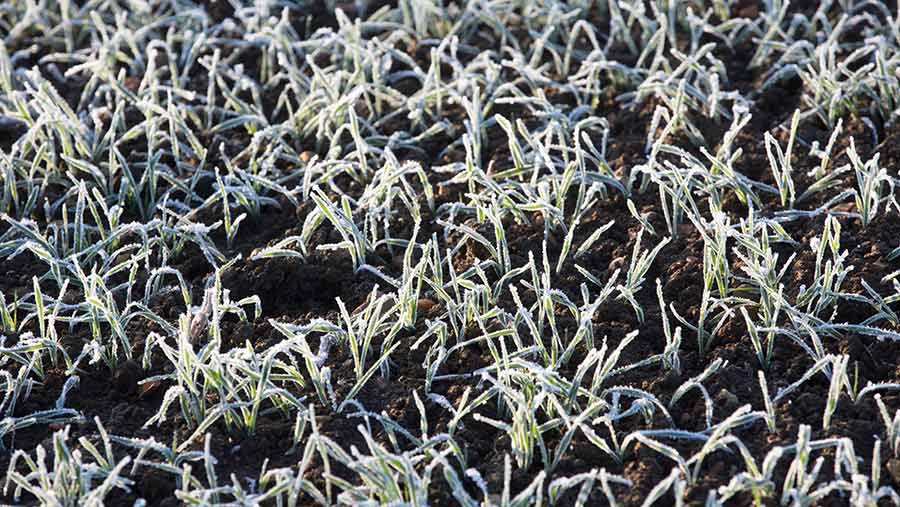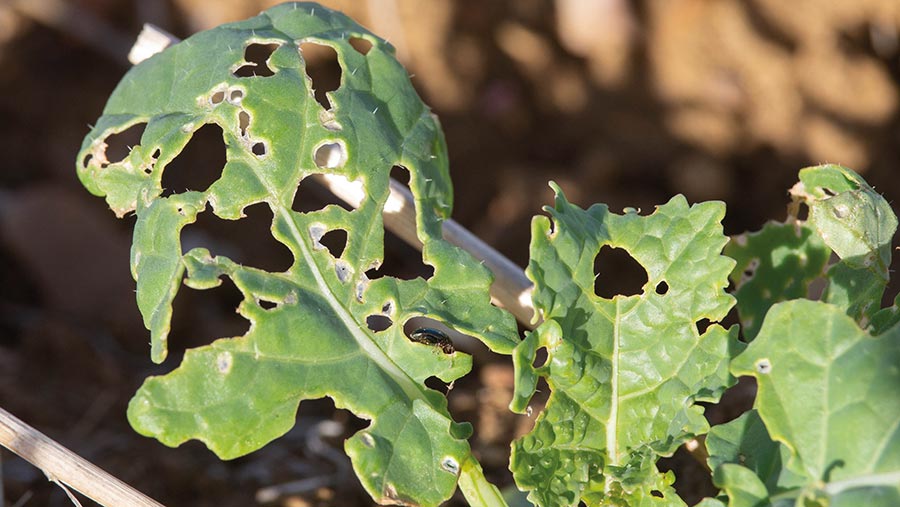Crop Watch: Frost-lift and pest problems but not much warmth
 © Tim Scrivener
© Tim Scrivener Warmer spring weather is still awaited by many growers, with crops coming out of the winter being assessed for frost damage, plus a range of potential pest problems in cereals and oilseed rape.
Rolling is under way to try to remedy frost damage, while most early nitrogen applications have been made, so all that is needed is a bit of warm weather for crops to really start to take up this nutrition and grow away.
See also: How a world champion keeps his wheat free of disease
South
Iain Richards
Agrii (Oxfordshire)
After the climatic contortions of the season so far, we are making absolutely no weather assumptions, being prepared for anything and taking every opportunity we can for the most timely fieldwork.
As well as the worst gout fly I can remember in wheat since before the days of Deter, we have been having to cope with more damaging frost-lift in cereals than I’ve seen in my entire working life.
Thankfully, the bulk of the gout fly has been in earlier drillings, well-enough established to compensate for the tiller losses.
A mammoth rolling effort across thousands of acres has been essential, with cereals so badly lifted they could be brushed out of light chalky soils with the feet.
Our earlier wheat and barley sowings are, however, generally coming out of the winter in good shape, as is most of our OSR, which is pretty even, well-rooted and with a really good collar size despite having lost a lot of leaf in the cold.
With the frost-lifting, the lack of root development in many of our later-drilled cereals is worrying.
Alongside the much-needed rolling, near-perfect early conditions have allowed us to get a decent first 70-90kg/ha of nitrogen onto all our winter crops.
This will be vital in supporting the large amount of growing they still have to do – especially if the spring turns out to be another dry one.
It will also help compensate for the noticeably low soil mineral nitrogen levels being revealed in early tests.
With the frost damage, it’s difficult to tell how much light leaf spot there is in most of our OSR.
As it definitely won’t be needing a specialist growth regulator, we’re looking to apply Architect (mepiquat chloride + prohexadione + pyraclostrobin), which impressed us last year, for our stem extension spraying.
Generally low disease levels in wheats so far mean we’re struggling to see a T0 place for folpet even in most earlier drillings.
We’re keeping an open mind for now, of course. But, with fungicides less than 10% of our wheat growing costs and T0 responses of more than 0.6t/ha in last year’s Skyfall trials, we can’t risk the crown jewels when so much of the profit will be in the last tonne/ha – especially with a £50/t Group 1 premium.
We’ll probably be basing our T0s here on Sakura (bromuconazole + tebuconazole) plus an early plant growth regulator (PGR) to help with root development and tiller retention.
In later sowings where disease is far less of a concern, our emphasis will be firmly on a different balance of trinexapac and chlormequat plus Nutri-Phite PGA for greater rooting support and a useful bio-solution like the elicitor Iodus or the phosphite-based Curative.
We have also taken full advantage of the February weather to get more than half our spring barley and a good acreage of spring beans in.
They’ve yet to come through, but they went into some great seed-beds, were well-rolled and are rooting well. This should stand them in really good stead, whatever the weather.
East
Becky Finbow
Agrovista (Norfolk/Suffolk)
A couple of weeks ago we were wandering over fields in the sunshine, revelling in what could have been the beginning of spring as drills and fertiliser spreaders descended on the land earlier than usual.
But at the time of writing, the weather has turned, temperatures have dropped and the rain has started once again.
This wet weather has allowed the first applications of nitrogen to be washed into many crops; oilseed rape being one of the first to receive its nitrogen in the East.
Unfortunately, some crops have not made it through the winter due to a mixture of pigeon damage and cabbage stem flea beetle larvae.
Some plants I have cut open have contained as many as 15 larvae, with the stems left completely hollow.
But it’s not all bad news. There are some really healthy oilseed rape crops around, which I’m sure now spring is on the way will go on to yield.
If only we knew the secret to keeping the dreaded flea beetle at bay, we could all be enjoying strong vigorous crops.
Walking over the winter wheats, the autumn herbicides have done a fantastic job; active ingredients such as flufenacet, DFF, aclonifen and tri-allate have given us excellent weed control.
A lot of farms this year used similar actives once again, as a follow-up residual herbicide alongside their BYDV sprays, in the hope of reducing the pressure on grassweed sulfonylureas.
With the good seed-beds and fine autumn conditions, in most cases this has done a very good job and successfully reduced our reliance of sulfonylureas and therefore prevented further resistance.
Nitrogen/sulphur applications on cereals are well under way, too, with most of the first dressings of 40-50kg/ha of nitrogen now on.
This application has provided the yellowing crops with some much-needed nutrition, with barleys turning back to green overnight.
With the spreading of fertiliser comes the ongoing frustration with fertiliser prices for growers, especially for those who have bought their requirements in good time.
A large price drop in the industry will unfortunately benefit only those who left buying fertiliser to the last minute this year, while others still have expensive invoices to pay.
West
Stephen Harrison
AICC/Southwest Agronomy (Avon)
Despite a spell of cold, dry weather, crops have made good progress following excellent establishment last autumn. Earlier concerns about mildew levels in winter barley have dissipated.
Our chief area of concern is around insect pests. Some wheat crops following AB15 (two-year sown legume fallow) have been hit hard by wireworm, and with no effective treatment options, prospects for these crops and any re-drilling look bleak.
Oilseed rape is generally OK, but there are some crops where plants are rotting and failing to make any spring growth.
This damage looks to be a result of one of three pests: cabbage stem flea beetle, rape winter stem weevil, or cabbage foot fly.
Their predations have severely weakened the plant, making it very susceptible to the frosty weather.
This issue is not widespread, but where it is seen it is very damaging. We are keeping our fingers crossed that surviving plants will be able to compensate.
One benefit of the frost has been the almost total annihilation of charlock. Light leaf spot is present, so an effective stem extension fungicide will be needed to follow up the autumn application.
Blackgrass control in wheat has been good where drilling was delayed until mid-October or later. Where pressure to drill earlier on heavier land existed, control has been poorer even using sequences including cinmethylin.
Surviving plants are now well-tillered and effective control from contact materials is unlikely.
On a brighter note, grassweed control in oilseed rape and winter beans from propyzamide has been as good as I have ever seen.
Cooler soils and prolonged uptake by the weeds is the significant factor. Winter beans have tolerated the frost well and look healthy.
On brashy soils on higher ground, we have seen frost-lift in winter oats. Some crops were rolled in the drier period to enhance root-to-soil contact and plant survival.

© Tim Scrivener
North
Conor Campbell
Hutchinsons (Northumberland)
An initial flurry of excitement mid-February, which saw sprayers and fertiliser spreaders being brought out from retirement, has been halted by the reminder that spring has not fully sprung and the wintery weather isn’t behind us just yet.
Thankfully, it hasn’t been the Beast from the East 2.0 that was threatened – if I had a pound for every time they got the forecast wrong, I’d be a very happy man.
Oilseed rape crops are picking up and many have received a small dose of nitrogen.
Pigeons have done some damage over the winter, particularly around the more urban areas, where the noise of a gas gun doesn’t go unnoticed and complaints quickly flood in.
Once the warmer weather returns these crops will begin to jump, especially where some early nitrogen was applied, so particular attention will be paid to the more forward crops, which may require a growth regulator to balance out the main stem and encourage some branching.
Winter barleys overall look well, albeit a touch yellow around the county. They will be grateful for their first dose of nitrogen when we can travel.
Disease levels vary with variety, with some net blotch kicking around and brown rust in the usual culprits. This will be tidied up in the due course, where needed, along with some early nutrition.
Wheats look very well, particularly the early sown crops, which are very leggy. A milder winter and, until this week, a milder start to the spring will favour disease pressure.
There are plenty of reports of yellow rust, and septoria isn’t hard to find. Autumn residuals have done a good job and we will be looking at grassweed herbicides in due course, careful to see some active growth and avoid any frosty weather.
This far north, spring drilling hasn’t begun yet. Spring beans will be first on the list once the conditions allow us to get on, followed shortly by spring barley.
I pray for a sensible forecast over the next month and not one that turns dry in the blink of an eye.

